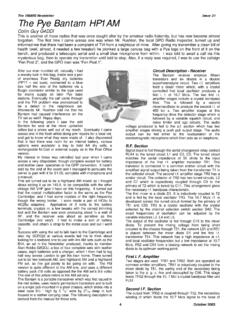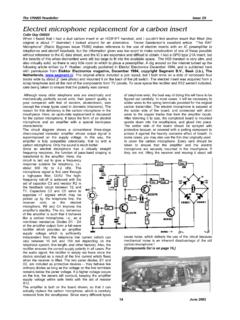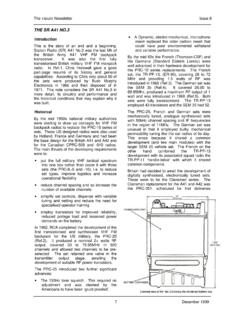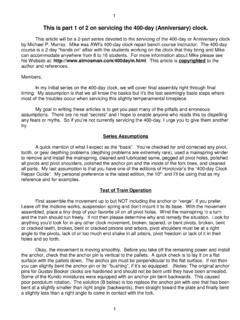Transcription of The SEM35 Manpack - VMARSmanuals
1 The VMARS NewsletterIssue 1211 August 2000 THE SEM-35 MANPACKby murray McCabeIntroductionThe West German SEM-35 VHF FM manpackradio is available from various UK and EUdealers. This note gives a brief description of theset, its historical relevance, circuit andperformance. The SEM-35 performance andcharacteristics are given in Table 1: SEM-35 SpecificationsFrequencyCoverage26 to spaced 50kHzModulationF3 (FM)Deviation15kHz RFOutput150 mW or 1 WattFrequencyStability< + from -40 to +600 CReceiverSensitivity< micro volts for 10dbreduction in S/NReceiverSelectivity> 80db at + 50kHzAF bandwidth400 to 3000 HzReceiver AFOutput50mW into 600 ohm or 600 ohmearth free line outputReceiverSquelchSwitchedWeightAppro x. 13kgAntennae1m nom.
2 Tape whip ( short ) self erecting whip ( long )SEM-25 remote antennaPower Supply24 Volt DC external (21 to 29V,32V transient max.)orInternal 12 off U2 cells - normalor NiCdOverall Size359x270x125 mmHistoricalMilitary radios do not just pop into result from a steady, progressiveimprovement to existing designs. Some,however, are landmark designs that made a majorstep forward. These resulted from acomprehensive, innovative, well financed andthought out development that appraised allaspects of a radio including the the case of VHF FM synthesised military radiosthe ground breaking design work was conducted inthe US in the 1950s and early 1960s. This was byforce of circumstance because, especially in theearly 1950s, only the US had the finance,resources and volume requirements to undertakeand justify the 'landmark' sets that resulted were the RCAPRC-25 VHF FM backpack radio and the AVCOVRC-12 VHF FM vehicle set.
3 Both sets covered30 to 76 MHz and both employed transistors. ThePRC-25 retained one valve in its transmitter RFoutput. The fully transistorised PRC-25 was laterissued as the was the arrival of the transistor that allowed thecomplexities of the synthesiser to be engineeredfor field use with acceptable physical size,performance and power supply US evolved a circuit configuration for military,synthesised VHF FM transmitter receivers thatwas almost as significant, in its field, as thedevelopment of the superhet. It consisted of a twoband receiver, synthesised in 50kHz steps by asingle band local oscillator. On the receiver lowband (30 to ) the received frequencywas local oscillator frequency minus intermediatefrequency (IF). On the high band (53 ) local oscillator plus IF frequency.
4 Thereceiver first IF was and each receiverband was twice IF frequency wide, 2 x =23 use of a single band local oscillator simplifiedband switching, reduced component count andprovided two working RF frequencies for eachsynthesised local oscillator transmitter frequency of the US radios waslocked to the synthesiser frequency by the use ofa crystal controlled 'side step' oscillatorthat beat with the synthesiser output frequency togenerate the transmitter frequency. Thissynthesiser configuration became the basis forsubsequent VHF FM military radio VRC-12 and PRC-25 were quite differentradios, because, internally and externally eachhad been optimised for its duty as a vehicle and amanpack set respectively. The PRC-25 replacedthe three valve sets of the PRC-10A series.
5 Themost important aspects of its design were itsruggedness, reliability and the basic simplicity ofits controls. It was not a prima ballerina requiringexcessive workshop attention and, in anemergency, anyone could pick it up and use itwithout previous training. The PRC-25 wasintroduced to US service in small quantity in 1961 The VMARS NewsletterIssue 12 August 200012but it was nearly 4 years later beforeit entered volume production ( ).SEM 35 DevelopmentWest Germany had used the USdesigned PRC-10 series radios. Bythe early 1960s they had arequirement for synthesised sets toupdate army VHF FM fieldcommunications. Their homeelectronics industry was by then re-established after the war.
6 Theydecided to develop the synthesisedsets themselves as a first foray in receiver synthesiser formatwould be based on the US work butlacking the US's budget, the Manpack and vehiclesets would be developed in a single transmitter would employ a simpler automaticfrequency loop similar from that used for earlierVHF FM radios such as the PRC-10. It would usean discriminator before the receiver IFfilter to regulate the transmitter oscillator from the receiver synthesiser would replace the PRC-25 side step crystaloscillator. It would be less accurate than the PRC-25 arrangement since it would rely on the tuningof a discriminator rather than an , the SEM-35 circuit achieved anacceptable transmitter frequency accuracy ofbetter than + from -40 to + German contract was awarded to StandardElektrik Lorrenz AG of Stuttgart.
7 The end resultwas the SEM-35 Manpack , the SEM-25 vehicletransceiver and the EM-25 vehicle receiver. TheEM-25 receiver is basically the SEM-25 hardwarein a SEM-25 case with the internal transmittersections omitted. The EM-25 is, therefore,externally similar to, and easily confused with, theSEM-25. The sets entered service in the SEM-35 was primarily intended as a manpackbut a vehicle mounting and a rebroadcast/relayadapter were produced for it and it could use theSEM-25 remotely tuned aerial base. Theseallowed the SEM 35 to fulfil vehicle, ground staticand re-broadcast/relay three sets share two common large-circuitmodules with obvious advantages in sparesholding and , the requirement that one programmedevelop both a Manpack and a vehicle setproduced conflicting goals.
8 As a result, the SEM-35 has features and components more appropriateto a vehicle radio. In this respect the mostobvious vehicle type component is a large multi-gang permeability tuner reminiscent of thetechniques employed in the auto radios of the DetailThe SEM-35 covers the early European tacticalspectrum of to rather than the US30 to 76 MHz spectrum of the PRC-25 and VRC-12. The set provides a total of 880 channelsspaced by 50kHz. These are covered in twofrequency bands. A high band from 47 to and a low band from 26 to MHz. TheSEM-35 has the same receiver first IFas the PRC-25 and each band could be 23 MHzwide permitting a low band of 24 to SEM-35 receiver can operate down to 24 MHz but the transmitter is automatically disabledbelow 26 MHz.
9 The tuning display is amechanical counter dial giving direct read out offrequency. The tuning arrangement does notpermit two channels to be pre-set as on the transmitter output power can be switched for150mW or 1 Watt RF output. The receiversensitivity is better than or equal to 10db signal-to-noise. Squelch is pre-set andselected by switch but it is not the US 150Hz battery box toggle clamps below the set andcontains a holder for 12 off U2 cells, either normalBA 30 or rechargeable cells. On a 9:1Rx:Tx ratio the BA 30 cells give a 14 hour lifewhile the NiCd cells give 20 hours per exhaustion, the minimum batteryvoltage for operation is quoted as Thebattery box also contains a transistor inverterproducing supplies of +6V, +16V, -17V and -30 VDC from the internal battery or from a 24 Voltexternal set uses a 1m laminated tape aerial and self-erecting whip like the PRC-25 but unlikethe US PRC ancillaries each whip has a tappedcup at its base that screws over a stud typeantenna mount on the set front panel.
10 The setstud base has a sprung piston at its centre which,when depressed, operates switches to select theappropriate antenna matching VMARS NewsletterIssue 1213 August 2000 With no whip fitted the set RF output is switchedto the 50 ohm BNC socket for connection to theremote antenna base. The cup on the bottom ofthe 1m tape antenna fully depresses the plungerwhile the cup on the bottom of the whip onlydepresses the plunger by about 50% of its similar antenna base is used on the WestGerman SE-6861 SSB Manpack set employs transistors throughout butbecause of its design age the transistors are a mixof PNP, NPN, germanium and silicon DescriptionEach receiver band has a separate RF amplifier(to simplify band switching).








